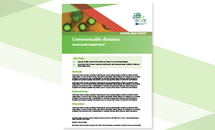Antimicrobial resistance in the EU/EEA (EARS-Net) - Annual Epidemiological Report for 2020
The results presented in this report are based on antimicrobial resistance (AMR) data from invasive isolates reported to the European Antimicrobial Resistance Surveillance Network (EARS-Net) by 29 European Union (EU) and European Economic Area (EEA) countries in 2021 (data referring to 2020), and on trend analyses of data reported by the continuously participating countries for the period 2016 to 2020.
Executive summary
Key facts
- Twenty-nine European Union/European Economic Area (EU/EEA) countries reported data for 2020 to the European Antimicrobial Resistance Surveillance Network (EARS-Net). Twenty-eight countries reported data for all eight bacterial species under surveillance by EARS-Net (Escherichia coli, Klebsiella pneumoniae, Pseudomonas aeruginosa, Acinetobacter species, Streptococcus pneumoniae, Staphylococcus aureus, Enterococcus faecalis and Enterococcus faecium), while one country reported data for all bacterial species except S. pneumoniae.
- The most commonly reported bacterial species was E. coli (41.3%), followed by S. aureus (21.9%), K. pneumoniae (11.9%), E. faecalis (8.4%), P. aeruginosa (6.2%), E. faecium (5.5%), S. pneumoniae (2.6%), and Acinetobacter species (2.3%).
- In 2020, the overall number of reported isolates at EU/EEA level increased compared to 2019 for all bacterial species except S. pneumoniae. These increases were not always observed at country level. For S. pneumoniae, on the other hand, there was both a large decrease in the overall number of isolates at EU/EEA level between 2019 and 2020 (44.3%; from 15 608 in 2019 to 8 689 in 2020) and similarly large decreases of 20% or more reported in all but one country.
- The AMR situation reported by EU/EEA countries to EARS-Net for 2020 varied widely depending on the bacterial species, antimicrobial group and geographical region. Overall, for the EU/EEA (excluding the United Kingdom), most of the bacterial species-antimicrobial combinations in this report showed either a significantly decreasing trend or no significant trend in the population-weighted mean AMR percentage during 2016−2020. The exceptions to this were carbapenem resistance in E. coli and K. pneumoniae, and vancomycin resistance in E. faecium, for which there was a significant increase during this period.
- In 2020, more than half of the E. coli isolates reported to EARS-Net and more than a third of the K. pneumoniae isolates were resistant to at least one antimicrobial group under surveillance, and combined resistance to several antimicrobial groups was a frequent occurrence. Among antimicrobial groups monitored for both species, AMR percentages were generally higher in K. pneumoniae than in E. coli. Carbapenem resistance remained rare in E. coli, but almost a quarter of EU/EEA countries reported carbapenem resistance percentages above 10% in K. pneumoniae. Carbapenem resistance was also common in P. aeruginosa and Acinetobacter spp., and at a higher percentage than in K. pneumoniae. For most gram-negative bacteria under surveillance, changes in the EU/EEA (excluding the United Kingdom) population-weighted mean AMR percentages between 2016 and 2020 were moderate and AMR remained at high levels, as previously reported.
- For S. aureus, a decrease in the percentage of MRSA isolates was reported during 2016−2020. MRSA nevertheless remains an important pathogen in the EU/EEA, with levels remaining high in several countries, and combined resistance to another antimicrobial group common. A decreasing trend was also seen during 2016−2020 for the percentage of macrolide resistance in S. pneumoniae.
- One development of particular concern was the increasing trend in the EU/EEA (excluding the United Kingdom) population-weighted mean percentage of vancomycin-resistant isolates of E. faecium, which increased from 11.6% in 2016 to 16.8% in 2020.
- The reported AMR percentages for several bacterial species–antimicrobial group combinations varied widely among countries, often with a north-to-south and west-to-east gradient. In general, the lowest AMR percentages were reported by countries in the north of Europe, and the highest by countries in the south and east of Europe. There was no distinct geographical pattern for vancomycin-resistant E. faecium.
Download

Additional tables - antimicrobial resistance in the EU/EEA 2020 - EN - [PDF-11.16 MB]
Country summaries - antimicrobial resistance in the EU/EEA 2020 - EN - [PDF-1.38 MB]







